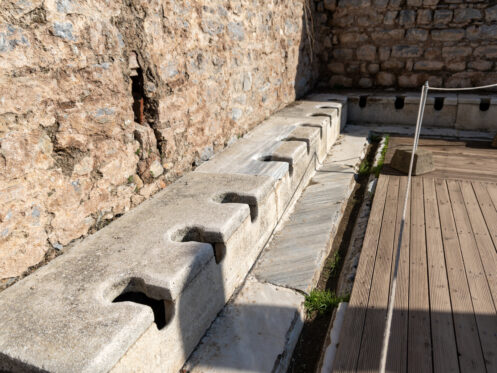Indoor plumbing is a modern convenience that many of us take for granted today. However, the journey to achieve the sophisticated systems we use now spans thousands of years and involves many civilizations and innovations. This article explores the history of indoor plumbing, answering questions like “when was indoor plumbing invented,” “who invented plumbing,” and detailing the significant milestones in indoor plumbing history.
Ancient Origins of Plumbing
The concept of plumbing can be traced back to ancient civilizations. The earliest known plumbing systems were developed by the Indus Valley Civilization around 2600 BCE. They had advanced drainage systems and indoor toilets connected to a complex network of brick-lined sewage channels. This early adoption of plumbing highlights the ingenuity of early societies in addressing sanitation needs.
Egyptian Contributions
The Egyptians made significant advancements in plumbing around 2500 BCE. They developed copper pipes to build elaborate bathrooms within their pyramids and palaces. Additionally, they implemented a rudimentary form of water management by creating irrigation systems that utilized the Nile River to supply water for drinking and agriculture. These innovations set a foundation for future developments in indoor plumbing.
Greek and Roman Innovations
The Greeks and Romans took plumbing to new heights with their sophisticated aqueduct systems, which transported fresh water from distant sources into cities and towns. The Romans, in particular, excelled in this area. By 52 CE, they had constructed a network of aqueducts, some of which spanned over 300 miles. This infrastructure supplied water to public baths, fountains, private households, and latrines. The Romans also developed lead pipes, known as “fistulae,” to distribute water efficiently.
The Roman Empire’s emphasis on public health and sanitation led to innovations like the development of the Cloaca Maxima, one of the world’s earliest sewage systems. This network of underground drains helped maintain public hygiene by removing waste from the city.
Medieval Plumbing Practices
After the fall of the Roman Empire, Europe saw a decline in public sanitation and plumbing systems. During the Middle Ages, most plumbing practices were rudimentary and unsanitary. People relied on chamber pots, and waste was often disposed of in the streets. Castles and monasteries were among the few places with rudimentary plumbing systems, utilizing simple pipes made from lead or clay.
Renaissance and Enlightenment Era Advancements
The Renaissance brought a renewed interest in science and innovation, leading to improvements in plumbing technology. In the 16th century, Sir John Harington, an English courtier, invented the first flushing toilet, called the “Ajax.” Although it was not widely adopted at the time, it laid the groundwork for future developments.
During the Enlightenment period, inventors like Alexander Cummings and Joseph Bramah made significant contributions to plumbing. Cummings patented the S-trap in 1775, which prevented foul odors from escaping through plumbing fixtures, while Bramah improved the design of the flush toilet, making it more practical for everyday use.
The Industrial Revolution and Modern Plumbing
The Industrial Revolution of the 19th century marked a turning point in the history of indoor plumbing. Innovations in manufacturing and materials allowed for the mass production of plumbing components. Cast iron pipes replaced lead pipes, reducing the risk of lead poisoning. The introduction of pressurized water systems enabled running water to be supplied to individual homes, revolutionizing daily life.
In the United States, the development of indoor plumbing gained momentum in the mid-1800s. Cities began to build centralized water supply and sewage systems, improving public health and sanitation. The first integrated plumbing systems in homes featured hot and cold water faucets, bathtubs, and flush toilets.
20th Century and Beyond
The 20th century saw further advancements in plumbing technology. The introduction of copper piping, plastic pipes like PVC and PEX, and advanced water filtration systems improved the reliability and safety of indoor plumbing. Innovations like tankless water heaters, low-flow toilets, and smart plumbing fixtures have made modern plumbing more efficient and environmentally friendly.
Today, indoor plumbing is an essential part of everyday life, providing clean water for drinking, cooking, bathing, and sanitation. Modern plumbing systems are designed to be efficient, durable, and safe, thanks to centuries of innovation and development.
Conclusion: The Evolution of Plumbing
The history of indoor plumbing is a testament to human ingenuity and the relentless pursuit of improving living conditions. From the ancient civilizations of the Indus Valley and Egypt to the sophisticated systems of the Romans, and the modern conveniences of today, plumbing has come a long way. Understanding when indoor plumbing was invented and who contributed to its development helps us appreciate the comfort and convenience we enjoy today.
If you have any HVAC or plumbing needs, don’t hesitate to contact Sierra Air Conditioning & Plumbing. Our experienced team is here to ensure your home remains comfortable and your plumbing systems operate flawlessly. Call us today for top-notch service and expertise.





